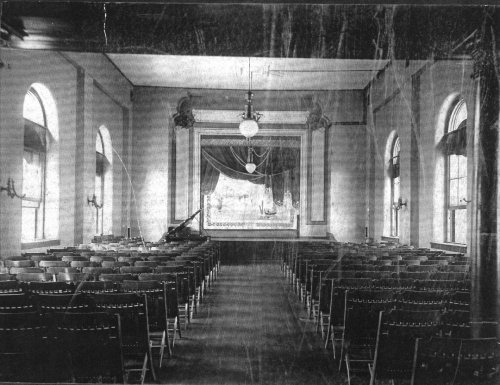

Amusement
Hall. This photograph of the Main Building's "Amusement Hall"
(which was sometimes referred to as "the Chapel") can be specifically dated to
18991.
The hall was used primarily to provide
ambulatory patients with regular entertainment -- such as live performances and
dances. The following passage from the 1909 Annual Report of the Board of
Managers gives examples of the types of entertainment that were provided in that
year:
"The fancy dress balls held several times during the year are always well
attended. In addition, there have been several moving-picture
entertainments under the direction of Messrs. Pearce & Scheck, of Baltimore;
illustrated songs2 by Professor Loose; vaudeville performances by Mr. Howard
Ramsay; chalk talk3 by Mr. Congdon and Mr. Hamilton; song and dramatic evening by
Mr. Edward Brigham, and a graphophone4 entertainment by the courtesy of Mr.
Albert H. Hock."
The Amusement Hall was located on the second floor of the Main Building, in
the rear of the center section, above the kitchen. Initially, the Main
Building lacked a large auditorium in which to hold live performances, other forms of
entertainment, and religious services. However, this deficiency was corrected a few years after the
building opened when, in 1877, the Amusement Hall was created in a large and,
evidently, previously unused existing space. As described in the Annual Report of the Board
of Managers in 1877, the then new hall was
"fitted up as a place of amusement,
where the tedium of many idle hours is beguiled in dances, concerts, musicals,
&c." The report also notes that additional forms of entertainment
that year included "negro
minstrel shows" and an outdoor band concert. Later reports reference
the use of the room for "cakewalks"5 and annual costume balls. Dr. Charles W.
Chancellor, the President of the Board of Managers in the year that the
Amusement Hall was added, memorialized his opinion that various forms of entertainment
that were offered in the Amusement Hall provided "good service in diverting
the mind from its morbid fancies and by directing it into healthier
channels." As noted above, the Amusement Hall was also sometimes
referred to as the Chapel, because it was used for many years to hold
separate Protestant and
Catholic worship services on Sundays. It continued to be used as an
auditorium until the middle 1930s, when the space was converted into a
patient ward and a "congregate dining room." The free-standing
Thomas-Rice Auditorium6 was opened across from the Main Building in 1936.
_____________________________________________________________________
Notes:
1. This photograph appeared in the Maryland Hospital's Annual Report of 1899. The report describes the folding chairs that are seen in the picture, and notes that these chairs were purchased for the Amusement Hall in that year.
2. The "illustrated song" was a popular form of vaudeville entertainment at the turn of the 19th Century. Illustrated songs involved the projection, onto a screen, of (still) pictures that illustrated a song as the performer was singing it. Ada Jones, a popular illustrated song performer of the day, was known for her rendition of the song, "Everyone is in Slumberland But You and Me," and it may be interesting to note that the title of this song appears in the needlework seen on the link to the Main Building's female Industrial Therapy Department.
3. A "chalk talk" was a lecture or talk, often informal, illustrated with diagrams or other drawings chalked on a blackboard.
4. The "Graphophone" (an inversion of the word "Phonograph") was an early device for recording and playing sound. Similar to Edison's phonograph, the graphophone included several technological advances - such as the of cutting a zig-zag spiral groove in the wax surface of a record to improve sound quality. Edison's early recordings were made on foil cylinders or other relatively hard surfaces.
5. The "Cakewalk" refers to a form of public entertainment, popular during the 19th and early 20th-century, that involved a strutting dance -- often, but not necessarily, performed in minstrel shows. In some cases, the walkers performing the most accomplished or amusing steps won cakes as prizes.
6. Thomas-Rice Auditorium. People familiar with Spring Grove today may not realize that the building now commonly known as the "Rice Auditorium" is actually named the "Thomas-Rice Auditorium" -- or they might mistakenly assume (understandably) that the Thomas-Rice Auditorium was named after a man named "Thomas Rice." In fact, the building was named for two men: Robert W. Thomas and G. Herbert Rice. Both men were members of the Spring Grove State Hospital Board of Managers at the time the auditorium was built, and, not unlike Arthur D. Foster, after whom the Foster-Wade Building is named, Mr. Rice served as the Board's Secretary-Treasurer. The lower floor of the building, the space now occupied by Pastoral Services, was originally used as an occupational therapy department. When the Thomas-Rice Auditorium opened in 1936, the hospital had plans to use as the home of "an orchestra of the musically inclined patients." The Rice Auditorium's two original movie projectors are still located in its projection room.